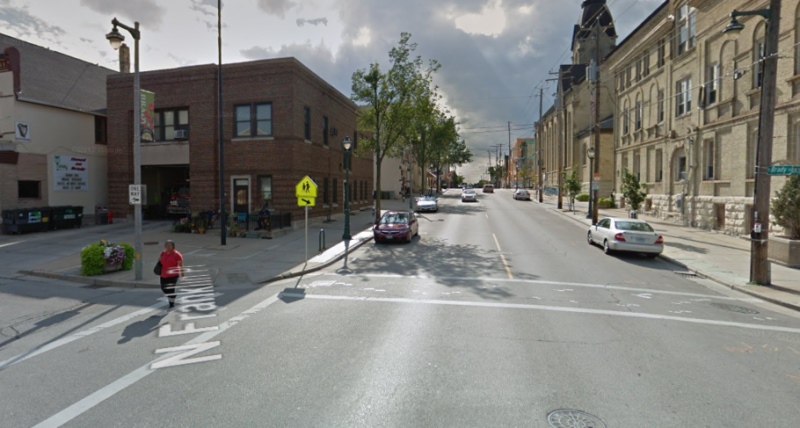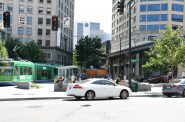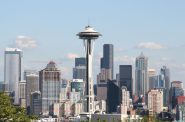Most Drivers Don’t Yield to Pedestrians
UWM study finds just 16% of Milwaukee drivers yielded right of way at unmarked intersections.

Few motorists yield to pedestrians at crossings like this one at Eeast Brady Street and North Franklin Place in Milwaukee. Image: Google Street View
Scan the typical coverage of pedestrian fatalities, and you’ll see a lot of assumptions about texting “zombies” or kids darting out of nowhere.
Those are the stories you tend to hear when victims can’t tell their side of the story. And they obscure a much more important question: Are drivers behaving safely behind the wheel?
A new study from researchers at the University of Wisconsin-Milwaukee finds that by one critical measure, they’re doing pretty poorly. Only one in six drivers they observed lawfully yielded to pedestrians. But on some streets, drivers were more likely to behave carefully around people on foot.
Professor Robert Schneider and his team tracked behavior at 20 intersections in Milwaukee without traffic lights or stop signs, observing 364 drivers with an opportunity to yield to crossing pedestrians between 5 p.m. and 7 p.m. on weekdays.
The speed limit on all observed streets was either 25 or 30 mph. Drivers were 6 percent more likely to yield on streets with a 25 mph speed limit than streets with a 30 mph limit.
Crossing distances also had a statistically significant effect on yielding. For every reduction in crossing distance of five feet, drivers were 1.1 percent more likely to yield.
The team found that drivers were 2 percent more likely to yield to white pedestrians than black pedestrians. Other researchers in different cities have observed larger racial disparities in driver yielding behavior.
Drivers were also slightly more likely to yield to pedestrians who behaved “assertively,” either by standing in the roadbed before crossing or by raising an arm to signal intent, which the researchers linked to a 1.8 percent increase in yielding behavior.
For street engineers, the implications are clear. The more the street environment — with lower traffic speeds and narrower crossing distances, the more likely drivers will yield to pedestrians.
The paper was presented in poster form at the Transportation Research Board’s annual meeting in January and will be published in an upcoming edition of the Transportation Research Record.
Story by Angie Schmitt. A version of this story originally ran on Streetsblog. Angie Schmitt is a newspaper reporter-turned planner/advocate who manages the Streetsblog Network from glamorous Cleveland, Ohio. She also writes about urban issues particular to the industrial Midwest at Rustwire.com.
Streetsblog
-
Car Culture Cements Suburban Politics
![Sprawl. Photo by David Shankbone (David Shankbone) [GFDL (http://www.gnu.org/copyleft/fdl.html) or CC-BY-SA-3.0 (http://creativecommons.org/licenses/by-sa/3.0/)], via Wikimedia Commons [ https://commons.wikimedia.org/wiki/File%3ASuburbia_by_David_Shankbone.jpg ]](https://urbanmilwaukee.com/wp-content/uploads/2017/10/1024px-Suburbia_by_David_Shankbone-185x122.jpg) Nov 23rd, 2018 by Angie Schmitt
Nov 23rd, 2018 by Angie Schmitt
-
Jobs Up Yet Driving Down in Seattle
 Feb 22nd, 2018 by Angie Schmitt
Feb 22nd, 2018 by Angie Schmitt
-
Seattle Adds People Without Adding Traffic
 Dec 20th, 2017 by Angie Schmitt
Dec 20th, 2017 by Angie Schmitt
Transportation
-
MCTS Adds 28 New Buses
 Jul 13th, 2024 by Graham Kilmer
Jul 13th, 2024 by Graham Kilmer
-
MCTS Designing New Bus Shelters
 Jul 10th, 2024 by Graham Kilmer
Jul 10th, 2024 by Graham Kilmer
-
MCTS Updates RNC Bus Detours To Better Serve Downtown, Riders
 Jul 9th, 2024 by Jeramey Jannene
Jul 9th, 2024 by Jeramey Jannene






















Rule of thumb: while driving on Brady Street, drive as if pedestrians are trying to get hit. Ignore the driver that’s 2 inches from hitting your bumper. Keep your eyes peeled. Additionally, it is often impossible to see pedestrians at the cross of Brady and Franklin at certain times of the day due to the incline and how the sun hits the area. Remedy: prentend there is always a person in the street. Side note: years ago cars Officer Rufus sat on his Harley all day ticketing those who failed to yield. It not only decreased the problem, but his presence led to an overall safer Brady St. My personal opinion: speed bumps would be extremely helpful.
Kliff, I must beg to differ. Speed bumps are not a helpful solution. And before anyone suggests it, neither are four-way stops at residential intersections. I worked for the City for many years and consistently, in neighborhoods where people begged for these “solutions” they’d inevitably call back soon after their installation to report that they weren’t working Why? Because drivers will drive too fast, slow down to go over the bump / pause at the stop sign….then immediately zoom back up to speed again.
All they do is create a pause. They do not motivate people to consistently drive slower all the time. And they do not motivate people to be more aware of pedestrians.
This is a really complicated issue. I sometimes stop for pedestrians and other times don’t. It depends on how likely I feel I will get rear-ended by the person behind me. Can they see the pedestrian too, or will my sudden brake lights surprise them? Do they also have somebody driving right behind them, and how fast? If the pedestrian is safely waiting on the curb, I’d rather drive on than cause a 3 or more car bumper-busting. I walk across Lincoln Memorial often by the lagoon Pedestrian Xing signs, and rarely do cars stop – and I can see why. The speed limit is fast, and just after a green light by the marina, there’s a surge of traffic that could end up in a chain of rear-endings if someone stopped for me. I’d rather wait on the curb than endanger several other people’s safety!
There are many locations throughout the country where vehicles routinely yield to pedestrians. They are raised and trained in an environment that promotes that concept. We are not.
The Wisconsin state statute reads: 346.24 Crossing at uncontrolled intersection or crosswalk.
(1) At an intersection or crosswalk where traffic is not controlled by traffic control signals or by a traffic officer, the operator of a vehicle shall yield the right-of-way to a pedestrian or personal delivery device, or to a person riding a bicycle or electric personal assistive mobility device in a manner which is consistent with the safe use of the crosswalk by pedestrians, that is crossing the highway within a marked or unmarked crosswalk.
(2) No pedestrian, personal delivery device, bicyclist, or rider of an electric personal assistive mobility device may suddenly leave, and no personal delivery device operator may allow a personal delivery device to suddenly leave, a curb or other place of safety and walk, run, or ride into the path of a vehicle which is so close that it is difficult for the operator of the vehicle to yield.
(3) Whenever any vehicle is stopped at an intersection or crosswalk to permit a pedestrian, personal delivery device, bicyclist, or rider of an electric personal assistive mobility device to cross the roadway, the operator of any other vehicle approaching from the rear may not overtake and pass the stopped vehicle.
As a driver it is sometimes tricky to understand the intent of pedestrians. I have stopped for people by the crosswalks on Brady Street only to find out that were just hanging out (not crossing the street).
I have the same concerns as Amy Butterfield. In addition, in many residential areas, parking is so hard to find that a lot of people (break the law and) park right up to the corners, making it difficult as I approach to see if someone is waiting on the curb or in the crosswalk. Perhaps ticketing cars parked within 10 feet of a crosswalk or stop sign could mitigate this particular cause of the problem? The City could also be more diligent about refreshing the paint on crosswalks. Sure, a lot of drivers will *still* not slow down, but plenty of us respond to that visual reminder to slow up in case someone’s there.
@ blurondo is correct. There are many other parts of the country in which pedestrian rights are respected and they are yielded to at intersections. All things considered, California is such a place. While not perfect, CA drivers typically stop for pedestrians regardless of where they are in crossing. I lived and walked in San Francisco for 16 years.
Another key difference is the assertiveness of pedestrians. I walk much more than I drive and even got rid of my car six years ago, now living in Chicago. Fact is, if a pedestrian is standing on the corner, most any WI (or IL, or OH) driver will assume that the pedestrian is yielding the right of way to the driver. The “assertive” pedestrian move of “by standing in the roadbed before crossing or by raising an arm to signal intent” would hardly be considered assertive most anywhere else. Standing in the gutter would still be viewed as yielding to the auto. Raising you hand at the corner is hardly a clear statement of intent. It’s more of a meek request to accept the right of way.
Pedestrians need to learn how to occupy their rightful right of way while also being safe. Without getting into all the permutations of this and there are many based on speed, traffic, sight lines, number of pedestrians, etc., it basically involves moving squarely into the crosswalk while looking directly at the car and the driver. Far from being a game of “chicken,” this is the way pedestrians assertively message intent. I’ve done it a million times and I’m still here. The real issue is at uncontrolled intersections that also happen to be busy. If it is busy but I also have more than enough space-time to get will into the crosswalk, there I go!
Naturally, no one is recommending jumping out in front of a close, fast-moving semi. If it’s not a busy intersection and there’s a sole car approaching, I as a pedestrian am likely not going to be a jerk and make that single care wait for me.
Drivers can be jerks and, in places like WI, they assume the right of way way too much. Pedestrians can be fools. California is home to yielding pedestrians the right of way, and also to stupid pedestrians. (Weird how that works.)
One thing you sometimes see these days are intersections with clear ways of signaling that pedestrians must be yielded to–from extra bright signs right before the intersection, to bright-orange flags that pedestrians pick up and carry with them to the other side of the street, to high-tech crosswalks with lights embedded in the roadway that blink once a pedestrian steps off the curb.
Or, better education…
Pedestrians have a responsibility, too. The road is a dangerous place that demands respect.
Pedestrians should make the effort to not walk in front of cars or bicycles.
Lower speeds & other restraints & devices that increase anxiety will not increase the safety of the roads, but only increase the dangers.
Use caution. Look both ways before crossing (“look three times”).
It is up to you to act for your own safety. Blindly walking into the street, no matter the laws, or the design, will greatly increase the danger to your ownself & others.
Take responsibility for your own safety no matter how you are traveling on the road. Remember any law or supposed design concept cannot change the physics of the world. Walking in front of a moving motor vehicle or bicycle greatly increases one’s chances of injury & death.
It is upon oneself to increase one’s safety by using caution, & right action, which can include assertive action, yet, one needs to remember the realities one is dealing with & not be lulled into carelessness or a sense of complacency.
Your loved ones will be hurt if you are killed or injured.
Safety is everyone’s responsibility. Take the proper actions.
Robert Rands wrote “Lower speeds … will not increase the safety of the roads, but only increase the dangers.”
That is so not true.
The pedestrian death rate in 20 mph collisions is 7%, but at 30 mph, that nearly triples—to 20%. And for 30-year-old pedestrians, the difference is even more dramatic—a four-fold increase in fatalities (3% vs 13%).
Speed kills. On residential streets, twenty is plenty.
https://www.propublica.org/article/unsafe-at-many-speeds?utm_campaign=sprout&utm_medium=social&utm_source=twitter&utm_content=1464207000
That Robert Rands post is bizarre. In addition to being factually challenged as pointed out by TransitRider, he makes painfully obvious statements like pedestrians should watch out for cars and not walk in front of a bike or vehicle. Well yeah no kidding man.
I am a life long pedestrian and cannot think of a time when drivers were so distracted and rude, drove so fast and generally behaved so recklessly. I live and work downtown in Milwaukee. Drivers are talking on their phones, texting, blasting music and not paying attention to what’s going on around them (same can be said about some pedestrians). I especially dislike those that are turning right and are only looking at on coming traffic before starting up their vehicle. I’ve almost been hit twice and I’ve taken to either yelling to let a person know that, hey, I’m trying to cross the street or just standing there until the fool is gone. This right on red traffic rule needs to go and speeders need to face much higher fines. Red on right has given drivers the green light to turn even when pedestrians are in the cross walk. And speeders are very frequent downtown. I know this is a city wide problem and I hope who, the police and those we elect to hold office can do something about this ever increasing threat to the well being of the public.
This entire situation is a frustrating puzzle to me. Whatever happened to the virtually universal understanding, coupled with corresponding behavior, that streets are primarily for vehicles? Thus those who need to watch out are pedestrians! The factor, mentioned above, of being rear-ended by a vehicle behind us who cannot anticipate our sudden yielding to a ped, is indeed a serious issue, which was exemplified a few years ago in Whitefish Bay with the death of a ped under those circumstances. Why would peds have the right of way in a place designed not for them but for vehicles? What is so hard about peds waiting until there are no cars coming before attempting to cross the street? This, again, was the universal understanding and practice not that long ago; were there more ped injuries and deaths then? I greatly doubt it. This whole issue could be laid to rest by a simple, universal emphasis of the obvious: Pedestrians, be careful. Cross at controlled intersections when possible, and elsewhere, look both ways and wait!
Jonathan your quaint notions of a time when pedestrians respected automobiles might have applied in 1980, but in 2018 it just doesn’t fly. You write like someone who doesn’t drive anymore. The problem now isn’t pedestrians not respecting cars. It is distracted driving and speeding. Those are far bigger issues these days. Not sure why you think otherwise.
I used to work on Brady Street. A regular comment I’d hear from the young ones was “Let them hit you. It’s their fault and you can sue them.” Uggg…silly ones. Your body will never be the same.
Greendoor, who disagreed with my first comment, I would like to then propose that we add even more speed bumps. Completely disable the ability to drive fast on Brady Street.
I agree with the comments above stating that drivers have become more reckless. The decreased police presence and the police priorities of live and living far outweigh traffic violations. I predict the problem will get worse as the baby-boomer cops retire along with the decision to further cut the force. I admit that I’m guilty of running lights. In my defense, I’m willing to pay a ticket over getting car-jacked. I’ve already lost one car this way. Call me paranoid, but I now purposely practice avoidance of having it happen again. I leave enough room in front of me so I can get away, I don’t trust groups of young pedestrians, if someone would hit my bumper I would continue driving and report it later, and I run lights. I’m not changing this behavior until there’s a significant decrease in the threat. I’ll just take the ticket.
Before automobiles, the “universal understanding” was that streets were shared by horses, horse-drawn vehicles, streetcars, and pedestrians. There is a 10-minute movie shot out the front of a San Francisco streetcar back in 1906. One fascinating thing about this film (other than the fact that almost everything you see was destroyed a few days later by the 1906 earthquake) is how nonchalantly people crossed the street. Nobody cared about crossing at the corner (crosswalks weren’t even invented); vehicles were simply expected to yield to pedestrians.
https://www.youtube.com/watch?v=dGloeX1SpAU
So what happened since then? In the 1920s, automobile interests coined the term “jay-walking” to describe anybody (other than somebody leaving, or returning to, a parked vehicle) crossing a street other than at a corner. It was a class thing—rich car owners (even middle-class people didn’t have cars back then) claiming public property as their own.
Read more here:
https://www.salon.com/2015/08/20/the_secret_history_of_jaywalking_the_disturbing_reason_it_was_outlawed_and_why_we_should_lift_the_ban/
Bad driving is a common theme on r/milwaukee and this “fear of rear ending” argument is a great example of the dysfunctional driving culture here.
Sub 35 mph city streets have constant traffic interruptions. If you’re not prepared to stop for traffic signals, left turners, parallel parkers, buses, delivery trucks, garbage trucks, utility vehicles, construction vehicles, and especially cyclists and peds then you are deeply negligent.